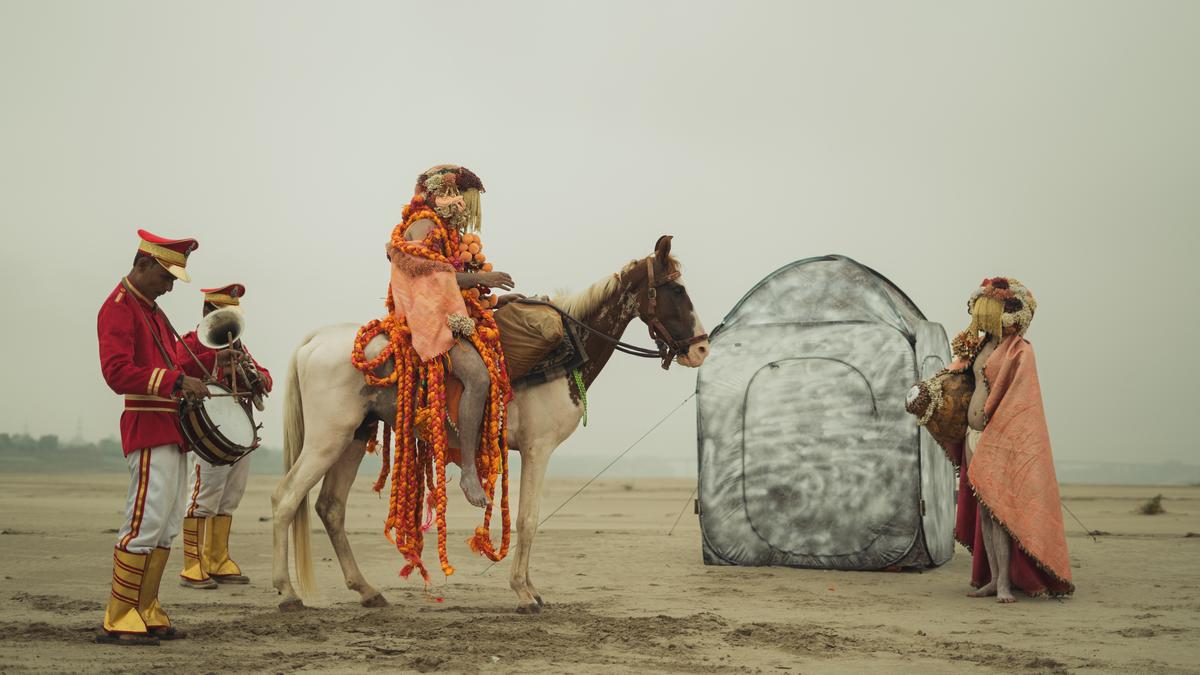
A walk down the queer side of Varanasi | Debashish Paul’s first solo exhibition
The Hindu
Artist Debashish Paul explores queerness through performance art, sculptures, and sketches inspired by Varanasi and his personal experiences.
“Varanasi feels like a very queer city to me,” says artist Debashish Paul, speaking of his adopted home where he presently lives and works since finishing his Masters’ in sculpture from the Banaras Hindu University in 2021.
For his first solo exhibition, A Thousand Years of Dreaming, at Kolkata’s Emami Art, he channels “the playfulness, colours and ecstasy of living in Varanasi — its open landscapes, its crowded alleys, its grand ghats — its own special kind of queerness” into still performance images, sketches and sculptures.
“I’ve seen the ease of boys holding hands, bathing together, and celebrating each other’s bodies in the River Ganges, and they aren’t burdened, they’re free with one another,” he says, during our telephone conversation. For him, these men don’t need “to translate their affections for each other” through a layer of queerness. And for Paul, his performance art practice allows for him to “slip” into his own sense of queerness.
It seems, his practice has always been a way for him to slip, slide and steal a path into himself. Growing up in Phulia in West Bengal’s Nadia District, the birthplace of Chaitanya Mahaprabhu, one of the significant saints of the Bhakti movement, he remembers always being part of the jathras or temple fairs in his village.
“As a queer child, I found myself constantly curious about my body, and was drawn to dance, movement, and theatre. From my school days, I have participated in the mythological dramas that took place at these jathras,” he says. “There I saw other boys and men dressing up as gods and goddesses. Around this time, I also found myself becoming fascinated with dressing up as a woman. So, I would play only the female roles in these plays.”
For Paul, these chances at embodying the flesh and bones of another has always been “a liberating playground for his imagination”. Occupying these events of religious and ritualistic rigmarole, he could “like Krishna become Mohini, or personify Shiva-Parvati as Ardhanareeshwara, half-man and half-woman”.
While the process of becoming these characters — applying the make-up or putting on the costumes — was like an exciting excursion into himself, over the years, he also began to notice that some of the other men were taking a similar pleasure in the performative aspects of these rituals, too. He began to see other queer men of his village, who were either married, were fathers or didn’t explicitly identify as such, “seemed to reveal themselves” while remaining hidden during the rest of the time. “I realised on these jathras that one could become anything: a man could become a god, a woman, a bird or an animal,” he recalls of his early epiphany. And his performance practice and the exhibition space allow this similar shift for him, observes Mario D’Souza, director of programmes and exhibitions at the Kochi Biennale Foundation and resident curator at HH Art Spaces in Goa, who curated this exhibition and has closely worked with Paul for over two years. “Interestingly, in the exhibition space, he [Paul] is an openly queer man talking about love and worship. I think this is what his performance body allows him to be — it allows him to be queer in public,” says Mario speaking to one of the constant themes in their conversations over these years.





















 Run 3 Space | Play Space Running Game
Run 3 Space | Play Space Running Game Traffic Jam 3D | Online Racing Game
Traffic Jam 3D | Online Racing Game Duck Hunt | Play Old Classic Game
Duck Hunt | Play Old Classic Game











